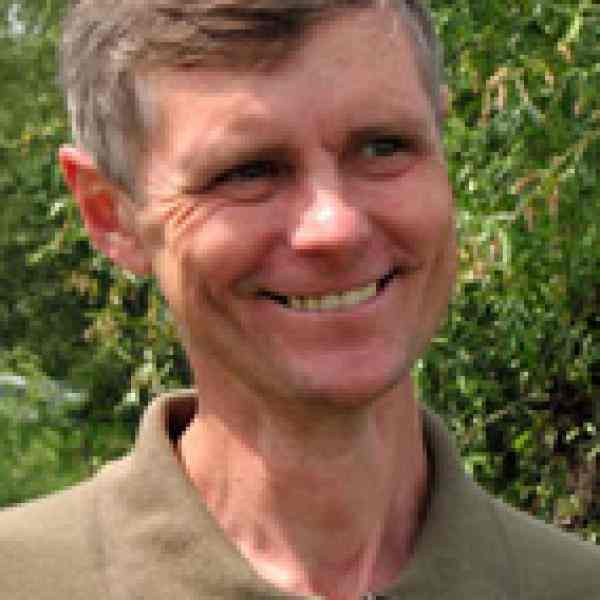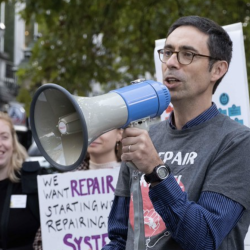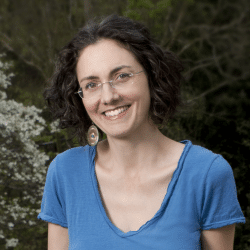Introducción
Pal Gera created the Foundation for Otters in January 1995 to protect otters and wetlands in Hungary and throughout Europe. Using otters as a means of galvanizing public support for environmental protection, Pal has built a comprehensive program focused on public education and community involvement.
La idea nueva
Pal and his Foundation for Otters are fighting to raise awareness of environmental protection through his work with otters and wetlands. His foundation is the only one in Hungary which concerns itself with otters and their habitats. Pal has discovered that the endangered otters are an effective symbol of environmental degradation throughout Europe, and can be used to mobilize public support for wetlands conservation, the maintenance of "green corridors," and the fight against illegal poaching. Pal also focuses on otters because they sit at the top of the food chain and are therefore important indicators of environmental health.
To achieve his objectives, Pal has created a comprehensive program and the first national network based on the involvement of volunteers, children, university students, experts and environmentalists, landowners, fishing and hunting organizations, and politicians. His network is uniquely successful in attracting cross-sectoral partnerships and making creative use of volunteer resources, and can provide a blueprint for successful social change movements in Central Europe. His program also features several unique components for wetland and otter protection including legal reform providing compensation for landowners, national surveys methods, an Otter Park and Ambulance, conference series, a strong and successful lobby, and youth education programs.
In Hungary, the environment is still neglected by government and civil society alike. The communist regime was opposed in principle to environmental protection because it seemed to detract from their philosophy of aggressive industrial development. Environmental protection was equated with general opposition to economic progress. In the 1980s, as the regime began to collapse and a more open political situation evolved, the government prepared an Environmental Law which did not specify punishments for violations and legalized higher pollution levels than in Western countries. This Law was not changed until 1997. From 1989 to 1997, there was no substantive control over the destructiveness of privatization.
El problema
The new 1997 Environmental Law is of the highest European standard, but as it was formulated during the change of governments, a substantial number of its regulations were not enforced because new state leaders (elected in 1998) did not authorize the changes. The state still provides only minimal support for the environment, and even this is gradually dwindling.
Between 1989 and 1993, a nascent environmental movement emerged in Hungary, but it was largely ineffective and waned in the following years. The few organizations who survive work against each other, competing for the same limited resources. Each loses its strength in the fight for money and for acceptance by the state and society at large. Hungary therefore remains an exception, even in Central Europe, in its low level of environmental awareness. Privatization and economic growth are unquestioned priorities which crowd the environment out of the public's awareness. Hungarian businesses are bitterly opposed to environmental regulations.
Otters have almost totally disappeared in Western Europe. Poaching is on the rise, and populations are fragmented and isolated. Today, the main causes in Western countries are the destruction of wetland habitats and water pollution. In Central and Eastern Europe, strong otter populations still exist, but significant deterioration is evident. Hungary plays a key role in saving otters and their habitats because the protection and growth of otter stocks in the Carpathian Basin is the seed for re-establishing otter populations in the West. If protection is well designed in Hungary and Czech Republic, otters will be able to repopulate the West and pressure can be applied to Western governments to restore wetlands and water purity.
La estrategia
The Foundation for Otters is grounded in the work of volunteers. A three-member board organizes and manages the different activities and fifty volunteers participate in the foundation's work throughout the country. Pal's strategy encompasses the following activities:
-National surveys: Pal convinced the Ministry of Environment and Regional Development to fund national surveys not only of otter populations, but also of the general condition of wetlands. In 1995-96, the first national survey was carried out by Pal's foundation. The second began in 1998 and is still ongoing. The national surveys have two main objectives: 1. Examining the territorial distribution of the Hungarian otter population: exploring dangers and formulating recommendations for protecting the species; 2. Judging the compensation of damages on fishing ponds caused by otters for wetland owners: identifying the degree and the scale of damage. Before the first survey began, Pal organized a conference with the participation of university students, local inhabitants, fishermen, hunters, and experts of nationally protected areas. Together, they designed the content of the survey and worked to recruit volunteer support. The conference was a great success, and 90 people volunteered. Fifty of them became a stable core for the foundation's work, and they form the heart of the national network.
-National Network: Pal's network of volunteers has been expanding steadily. The network will be fully functional by early 2000. In November 1999, he is organizing a conference for the volunteers to work out the network's program for cooperation with the state. The volunteers form a surveillance network that patrols otter habitats two to three times per month and reports environmental changes like deforestation and pollution.
-Education: With the help of the Budapest Zoo and the Otter Park Pal has created in Somogy, Pal organizes biology and environmental courses for students throughout the country. The courses in Budapest are attended by school classes from Budapest and the Otter Park is visited by classes from all over Hungary. His foundation also works with the Environmental Circle of the largest Hungarian university. Through this circle, he reached other youth groups and expands his network of young volunteers.
-International Cooperation: Pal is working on the realization of a common Czech-Austrian-Hungarian otter program for 2001-2002 with the aim of creating a green corridor to ensure the expansion of otters to Austria. This program is supported by the Austrian branch of the World Environmental Fund and Pal wants to involve Slovak and Polish organizations as well. The foundation is in contact with almost every Western European country. Pal established very strong cooperation with Czech and Polish organizations. In 1999, he found new partners in Slovenia and Croatia. Partner organizations exchange information about otters populations and wetlands, ensure mutual help, adapt new methods and programs, and organize reciprocal study visits. Pal has hosted Austrian, German, Czech, Slovene, and French groups eight times already.
-Otter Park: With the cooperation of the Somogy Environmental Organization, Pal established the Otter Park in June of 1998 in southwestern Hungary. He created this park with the aim of presenting otters in their natural environment and organizing an environmental programs for school classes. New construction is underway and several new buildings are being built. Two people manage the daily activities and are paid by the partner organization. In the beginning, the schools of Somogy county visited the park. Today, classes arrive from all over Hungary. Pal is planning to establish professional programs as well like a transportable otter ambulance and a national otter protection center with the cooperation of fishing organizations.
-Media and conferences: Pal emphasizes media and public events to enlighten citizens about the importance of environmentalism and the protection of wetlands and otters. He is always active in the media through published articles, interviews on "green" TV, and radio programs. He lectures at national conferences and participates in international conferences. In Hungary, he organized a series of conferences around the issues of environmental education, fishing, and hunting. Each conference was attended by 20-30 participants from very focused social and professional circles, e.g. university students, teachers, fishermen and hunters, experts and environmentalists. These conferences received significant media coverage, and have raised awareness of Pal's work throughout the country.
-Film and Video presentations: Pal has created different kinds of film and video presentations for various groups (school children, university students, experts, etc.). Presentations are 40-45 minutes long. When Pal wanted to reach children, he found that interesting, colorful performances were needed to get their attention. The presentation for children is not only about otters but about the general protection of the environment and animals. Presentations for experts are more serious and include the problems and solutions of otter preservation and wetland protection.
-Brochures and Books: The foundation provides citizens with brochures and books to spread information about the environment, otter protection, legal changes, etc. Some of these include: The Protection of Otters, Together with Otters, Ideas and Recommendations for the Future Protection of Otters, State support for Damage caused by Otters, The Long Term Strategy for Otter Protection, etc. The foundation sends these to schools, interest protection organizations, universities, environmental organizations, libraries, etc.
-Cooperation with Hungarian Nature Preserves: Pal is in a very close contact with all nine national nature preserves. They exchange methods and programs. These huge organizations ask Pal to conduct expert supervisory work for them.
-National Database: Pal is planning to compile all of the data collected by the foundation about otters and the environment and to make it easily accessible through a new database.
-Lobbying: Pal's lobby work has been mentioned several times and is one of his most important and successful activities. He was asked to participate in the creation of the new Environmental Law, convinced politicians to accept the idea of compensation, and put it into practice. Pal also worked out the methodology for assessing damage as well as its management and compensation. This methodology became the official national structure for damage revision and compensation and Pal's foundation manages this task.
La persona
Pal spent his summer vacations in the Hungarian plains at his grandparent's house where small villages are surrounded by lakes. As a child, he studied the fauna and he observed closely the relationship between nature and man. At that time, otters were not an endangered species and a great number of them lived in the lakes
When he was in high school, he traveled around the country in search of otters and conducted interviews with the inhabitants about them. In 1986, he has got a job at the Budapest Zoo in the Otter House. There he suggested and designed an otter propagation program. His work became the core of the Nature Protection Club at the largest Hungarian University, which formed an otter protection workgroup. In 1998, he won the prestigious Hungarian environmental Pro Natura award.
Pal still works at the zoo, cleaning cages and doing odds and ends to support himself and his work. When he does not make enough at the zoo, he also cleans apartments in the city to earn a living. He lives with and supports his elderly grandmother.




